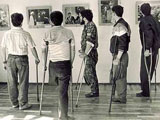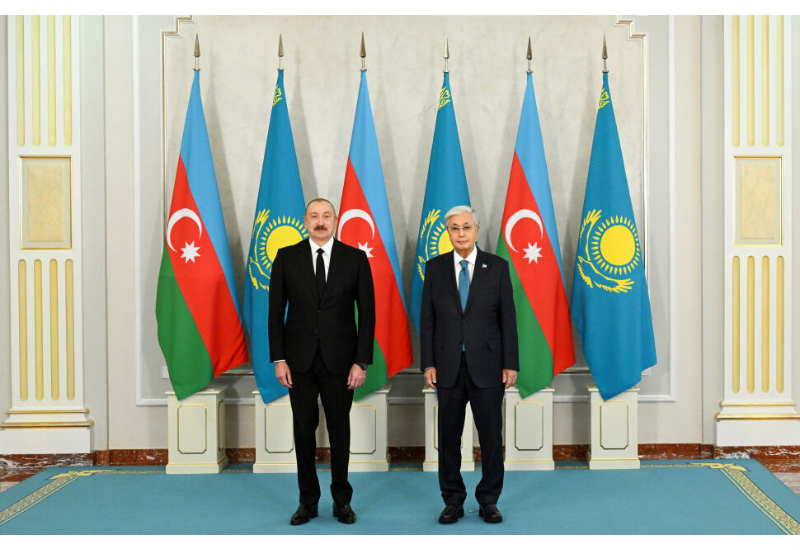|
|
TODAY.AZ / Analytics
Karabakh refugees still dream of return after two decades
25 September 2010 [11:37] - TODAY.AZ
 Azeri refugees, almost two decades after their expulsion, still live in a vacuum hoping to one day return to their hometown, which is part of a buffer zone in Nagorno-Karabakh, one of the Caucasus region’s most intractable conflicts. Screams and laughter from the children playing in the courtyard filter through the open windows into the classroom, where parents sit quietly, listening to Tunzala Velimamedova tell a wartime story.
Azeri refugees, almost two decades after their expulsion, still live in a vacuum hoping to one day return to their hometown, which is part of a buffer zone in Nagorno-Karabakh, one of the Caucasus region’s most intractable conflicts. Screams and laughter from the children playing in the courtyard filter through the open windows into the classroom, where parents sit quietly, listening to Tunzala Velimamedova tell a wartime story.“I had just begun a computer course when the rocket bombs fell. Then the Armenians came and we had to flee,” Velimamedova said. “We are victims, but the world has forgotten us.”
Velimamedova, 66, was the principal of the school in Agdam when war came to her town. Today, she manages a school in the village of Banovshalar, a name meaning “violet,” referring to the flower, and speaks about those who died in the fighting and the traumatic flight.
The home she longs for is just 10 kilometers away from Banovshalar; a few ruins and bomb craters overgrown by thorny bushes. What was once the town of Agdam has been occupied by Armenian soldiers since 1993, and is separated by a system of trenches, barbwire and minefields.
The Azerbaijani Ministry for Refugees subsequently built Banovshalar next to the armistice line of 1994. Some 2,000 people moved from tents to the newly built houses four years ago. The village has a health center, a post office, a kindergarten, a school and a library, and its many fruit orchards bear apricots and figs. But for Velimamedova, the new village, with its poetic name, is just another refugee camp, a place she will leave as soon as the conflict with Armenia is finally solved.
“Our army is strong. We will win,” she said.
The conflict over the territory of Nagorno-Karabakh, a constituent part of Azerbaijan that is inhabited and occupied by 150,000 Armenians, is, in the eyes of many international experts, a ticking time bomb, the next big crisis in the Caucasus.
The United Nations has called in several resolutions for the departure of Armenian troops from the occupied Azerbaijani territory, but even mediation from the Organization for Security and Cooperation in Europe has failed to resolve the status of the region.
War refugees such as Velimamedova are part of the game. Around 576,000 Azerbaijanis were displaced from Nagorno-Karabakh and adjacent areas, which together constitute almost 20 percent of Azerbaijan’s total territory.
Unlike Velimamedova, many of them do not live in new farmhouses, but are still – almost 18 years later – sitting in camps made out of old containers and make-shift boards.
Waiting for a solution
“Approximately 400,000 refugees live in precarious conditions. But 100,000 have already moved into new villages,” according to Ali Hasanov, a 62-year-old politician who has been the minister for refugee affairs since 1998. His office is located on one of the many broad avenues in Azerbaijan’s capital, Baku.
If there had not been any international aid after the war, there would have been a catastrophe, Hasanov said, but added that owing to its recent oil wealth Azerbaijan can now take care of the refugee problem by itself.
The almost 190,000 Azerbaijanis who have fled Armenia since 1987, the beginning of the conflict, are granted new land from the Azerbaijani government. The refugees from Karabakh and the occupied areas, however, can only lease land. “They will return to their homeland eventually,” Hasanov said, but he was unable to say when.
“We want a peaceful solution, but we are losing faith in the international institutions; maybe there will be war soon,” the minister said.
History tells a story
Both sides are fighting bitterly to impose their version of a historical truth on the conflict over Nagorno-Karabakh, which translates roughly into “black garden in the mountains.”
Claims in the dispute reach far back into the past: For Armenians, the territory represents ancient Armenian land, and thus a key to national unity. For Azerbaijanis, Karabakh belongs to an ancient Caucasian Albania, and is therefore part of Azerbaijan’s history. Who settled when and where first is often a question of life and death in the Caucasus.
“For us, historians are sometimes as important as politicians or generals,” said Ruslan Asad, who works for an international foundation in Baku.
The past dominates the presence at the zone of conflict, or the “line of contact,” as the OSCE calls it, where deadly clashes between Armenian and Azerbaijani soldiers often take place.
“But our anger over the dead is of no concern to the West,” said Vidadi Isayev, the governor of Tartar province, which, like Agdam, is divided by the conflict. He does not believe in the international organization’s ability to solve the bloody dispute.
“[For them, only a] secure oil supply matters,” he said.
Isayev wants to contribute to solving the deadlock with a symbolic project of his own, reinstating a monument dating back to Soviet times that was destroyed by Armenians. “With the monument, the Armenians thanked the Azerbaijanis for granting them permission to settle in Tartar 150 years ago,” he said, calling its destruction a testament to their guilt.
The governor added that it is impossible to take revenge on history. “It is more powerful than mankind,” he said.
The past has its own right, said Hasanov. He promised his mother he would bury her at her birthplace, next to her late husband – a place currently under Armenian control. “That’s how it will be, or her ghost will forever haunt me,” he said.
/Hurriyet Daily News/
URL: http://www.today.az/news/analytics/74066.html
 Print version
Print version
Views: 6596
Connect with us. Get latest news and updates.
See Also
- 23 October 2025 [19:22]
Azerbaijan’s role at UN: Model of constructive engagement and responsibility - 23 October 2025 [08:30]
Azercosmos harnesses AI technologies to tackle climate challenges - 22 October 2025 [20:15]
Why Armenian diaspora fears peace more than conflict - 22 October 2025 [08:30]
President Aliyev’s visit to Kazakhstan ushers in new phase of partnership - 21 October 2025 [20:58]
Peace on paper, claims in symbols: Armenia’s reform paradox - 21 October 2025 [08:30]
Azerbaijan’s green energy shift redraws map from Central Asia to Europe - 20 October 2025 [20:17]
Global faith in dollar outweighs commodity-backed alternatives - 19 October 2025 [15:23]
Reconstruction in Garabagh reshapes balance of power in Caucasus - 17 October 2025 [13:59]
Baku-Paris enter new diplomatic chapter as past misunderstandings fade - 16 October 2025 [17:44]
Washington relies on Azerbaijan, Pakistan and Indonesia to stabilise Gaza
Most Popular
 Alone in field is not warrior: time has come for military component of OTG
Alone in field is not warrior: time has come for military component of OTG
 Azerbaijan and Kazakhstan are taking region's geopolitics into their own hands
Azerbaijan and Kazakhstan are taking region's geopolitics into their own hands
 Azerbaijan’s green energy shift redraws map from Central Asia to Europe
Azerbaijan’s green energy shift redraws map from Central Asia to Europe
 Azerbaijan to begin satellite manufacturing, launches new space industry milestone
Azerbaijan to begin satellite manufacturing, launches new space industry milestone
 President Ilham Aliyev, President Kassym-Jomart Tokayev make press statements
President Ilham Aliyev, President Kassym-Jomart Tokayev make press statements
 Azerbaijan lifts all restrictions on transit of goods to Armenia - President
Azerbaijan lifts all restrictions on transit of goods to Armenia - President
 President Ilham Aliyev, President Kassym-Jomart Tokayev attend second meeting of Azerbaijan-Kazakhstan Supreme Interstate Council
President Ilham Aliyev, President Kassym-Jomart Tokayev attend second meeting of Azerbaijan-Kazakhstan Supreme Interstate Council
